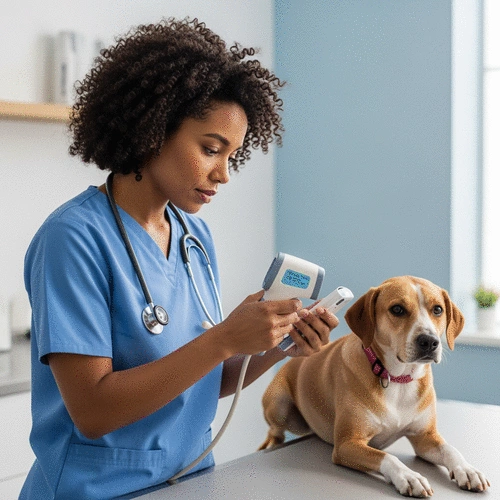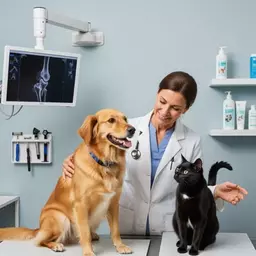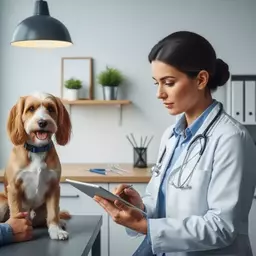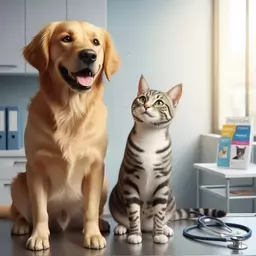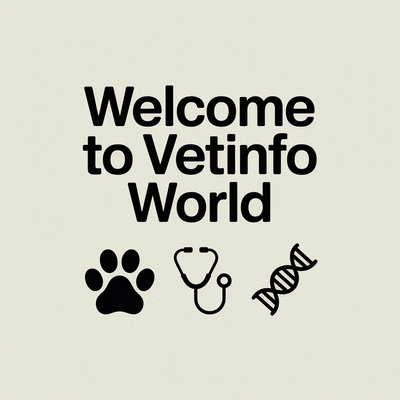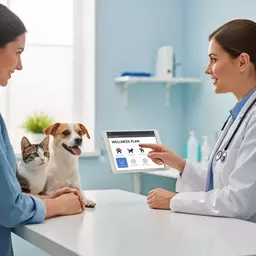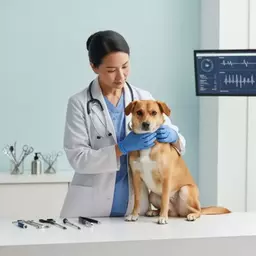How often do we underestimate the impact of advanced diagnostic tools in veterinary medicine? In 2025, these innovations are pivotal in enhancing the health and well-being of our beloved pets, enabling veterinarians to provide exceptional care.
What You Will Learn
- The importance of accurate diagnostic tools for early disease detection and tailored treatment plans.
- How technology, including telemedicine and AI, is transforming veterinary diagnostics.
- The advantages of Point-of-Care Testing (POCT) for immediate results and quicker treatment decisions.
- Key considerations for selecting diagnostic tools based on practice size and budget.
Veterinary Diagnostic Tool Considerations
Understanding what influences the choice of diagnostic tools is crucial for any veterinary practice. Below is a breakdown of key factors across different practice sizes and their associated considerations. For further insights into effective practice management, explore our guide on veterinary practice management software.
Key Needs & Considerations
- ✓Patient Volume & Case Complexity
- ✓Types of Diagnostic Tests Performed
- ✓Budget (Initial & Ongoing Costs)
- ✓Staff Training & Ease of Use
Practice Size & Tool Focus
Understanding Veterinary Diagnostic Tools in 2025
As a veterinarian with over a decade of experience, I understand just how vital accurate diagnostic tools are for effective animal care. In 2025, these tools have become more sophisticated, enabling us to detect health issues earlier and more accurately than ever before. Let's dive into why these advancements matter for veterinary practices like mine at VetInfo World!
Accurate diagnostics are essential not only for identifying conditions but also for tailoring treatments to each pet's unique needs. By using cutting-edge tools, we can enhance pet wellness and ensure that our furry friends receive the best care possible.

Why Accurate Diagnostic Tools Matter for Veterinary Practices
In the fast-paced world of veterinary medicine, having reliable diagnostic tools can significantly impact patient outcomes. When we can pinpoint health issues more accurately, we can provide timely interventions that can save lives. Isn't it incredible how a small device can make such a big difference?
- Early detection of diseases
- Improved treatment planning
- Enhanced communication with pet owners
These tools not only help in diagnosing conditions but also foster trust between veterinarians and pet owners. After all, when you can explain a diagnosis effectively, pet parents feel more involved and informed about their pet's health journey! For more on improving client relations, consider our insights on veterinary client communication strategies.
The Evolving Role of Technology in Veterinary Diagnostics
The veterinary field is undergoing a fascinating transformation as technology integrates into our daily practices. From digital imaging to AI-driven diagnostic engines, the role of technology is expanding. I'm continually amazed at how these advancements can expedite diagnosis and improve accuracy!
- Telemedicine for remote consultations
- Artificial Intelligence for data analysis
- Real-time monitoring tools for chronic diseases
These advancements not only streamline our workflow but also enhance the level of care we can provide. With technology at our fingertips, we’re better equipped to tackle the complexities of animal health.
Overview of Point-of-Care Testing (POCT) in Modern Veterinary Care
Point-of-care testing (POCT) has revolutionized how we approach diagnostics in veterinary practices. This method allows us to conduct tests directly in our clinics, providing immediate results that can lead to faster treatment decisions. I remember when I first introduced POCT in my practice; it felt like having a superpower!
- Rapid results for urgent cases
- Convenience for both vets and pet owners
- Reduced need for external lab testing
With POCT, we can quickly assess conditions such as kidney function or infectious diseases. This agility not only saves time but also enhances the overall pet care experience.
We Want to Hear From You!
What do you think about the integration of technology in veterinary diagnostics? Have you experienced any of these advancements in your practice or as a pet owner? Share your thoughts below:
Choosing the Right Diagnostic Tools for Your Practice
As a veterinarian, making the right choice in diagnostic tools can significantly enhance the quality of care you provide. At VetInfo World, I often emphasize the importance of selecting tools that not only fit your practice size but also align with your specific diagnostic needs. Whether you run a small clinic or a bustling veterinary hospital, understanding your unique requirements is essential for effective patient care!

To help you navigate this process, I've outlined key considerations based on the size and scope of your practice:
- Assess your patient volume and case complexity.
- Determine the types of diagnostic tests you perform regularly.
- Evaluate your budget for both initial investment and ongoing costs.
- Consider staff training and ease of use for the team.
By identifying these needs, you can streamline your decision-making process and ensure you invest in the right technology!
Identifying Key Needs Based on Practice Size
Different practice sizes come with distinct challenges and opportunities. A small clinic may prioritize cost-effective, portable diagnostic tools, while larger hospitals might invest in advanced imaging technologies and comprehensive laboratory setups. Here’s a breakdown of considerations based on practice size:
- Small Practices: Focus on versatile tools that offer multiple diagnostics, such as portable ultrasound machines.
- Medium Practices: Look for a balance between cost and functionality, integrating both imaging and lab capabilities.
- Large Practices: Invest in specialized equipment for advanced diagnostics, like CT scanners or MRI machines.
Understanding these dynamics can guide you toward making informed purchases that enhance your service offerings, ultimately benefiting your furry patients!
Recommendations Based on Diagnostic Accuracy and Cost
Finding a balance between diagnostic accuracy and cost-effectiveness is crucial. I've seen firsthand how certain tools can provide exceptional value without breaking the bank. Here’s my advice on selecting tools:
- Research tools that offer high sensitivity and specificity ratings.
- Consider user reviews and case studies to gauge performance in real-world settings.
- Explore leasing options or used equipment for significant savings on high-quality tools.
Investing in reliable diagnostic tools is not just about the initial cost—it's about enhancing patient care and supporting your practice’s growth! Discover more about optimizing your practice's financial health through efficient veterinary inventory management.
Evaluating Veterinary Endoscopy and Other Specialized Tools
Veterinary endoscopy is a growing field that can offer significant advantages in diagnostics and treatment. If you’re considering adding endoscopic equipment to your practice, here are some vital aspects to think about:
- Assess the types of procedures your practice intends to perform (e.g., gastrointestinal, respiratory).
- Evaluate the training and expertise of your staff in using such specialized tools.
- Consider the integration of endoscopic findings with other diagnostic modalities for comprehensive care.
With the right specialized tools, your practice can elevate its diagnostic capabilities and improve patient outcomes. Have you thought about how endoscopy could fit into your service offerings? For advanced surgical needs, you might also consider tools discussed in our article on veterinary surgical instruments.
Frequently Asked Questions About Veterinary Diagnostic Tools
- Q: Why are accurate diagnostic tools important in veterinary medicine?
- A: Accurate diagnostic tools are crucial for early disease detection, precise treatment planning, and ultimately, enhancing the health and well-being of pets. They allow veterinarians to identify conditions more quickly and tailor treatments to individual needs.
- Q: How is technology transforming veterinary diagnostics?
- A: Technology is revolutionizing veterinary diagnostics through advancements like telemedicine for remote consultations, Artificial Intelligence for data analysis, and real-time monitoring tools for chronic diseases. These innovations streamline workflows and improve diagnostic accuracy.
- Q: What is Point-of-Care Testing (POCT) and why is it beneficial?
- A: Point-of-Care Testing (POCT) involves conducting diagnostic tests directly in the clinic, providing immediate results. This is beneficial for rapid diagnosis in urgent cases, offers convenience for both vets and pet owners, and reduces the reliance on external laboratories.
- Q: What should I consider when choosing diagnostic tools for my veterinary practice?
- A: Key considerations include your practice's patient volume and case complexity, the types of diagnostic tests you perform regularly, your budget for both initial investment and ongoing costs, and the training and ease of use for your staff.
- Q: How do practice size and budget influence tool selection?
- A: Practice size and budget are significant factors. Small practices may prioritize versatile, portable tools; medium practices often seek a balance of cost and functionality with imaging and lab capabilities; while large practices might invest in specialized, advanced equipment like CT or MRI scanners.
Recap of Key Points
Here is a quick recap of the important points discussed in the article:
- Accurate diagnostic tools are essential for early disease detection and tailored treatment plans.
- Technology, including telemedicine and AI, enhances the accuracy and efficiency of veterinary diagnostics.
- Point-of-care testing (POCT) allows for immediate results, facilitating faster treatment decisions.
- Choosing the right diagnostic tools depends on practice size, patient volume, and budget considerations.
- Investing in advanced diagnostic equipment, like endoscopes, can significantly improve patient outcomes.

